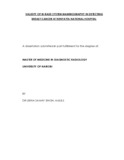Validity of bi-rads system mammography in detecting breast cancer at Kenyatta National Hospital
Abstract
In Kenya, breast cancer is the most common cancer
reported among women at 17.5%1. In Nairobi, the incidence among
women was reported at 23.3%, among all cancers for the period 2000-
20022.
The diagnosis of breast cancer may be established by the physical and
imaging examinations, but the definitive diagnosis is ascertained by
morphologic study (histopathology or cytology).
Within the various imaging modalities, mammography is an easy, noninvasive
imaging method to detect breast cancer with good accuracy3.
Previous studies done in Kenya concluded that the radiological accuracy
of mammography in detection of breast cancer is high3, and another
probed the usefulness of mammography in the investigation of
symptomatic patients less than 30 years of age4. However, it was found
that the mammographic reports were not standardized, lacked uniformity
and there was inconsistent use of imaging terminology. Also there was no
mandate to provide further patient management recommendations
based on imaging findings5. Keeping this in mind, in 1993 the American
College of Radiology (ACR) first developed the Breast Imaging-Reporting
and Data System (BI-RADS), in an effort to provide a quality assurance tool
that would standardize mammographic reporting, facilitate outcome
monitoring and reduce the ambiguity surrounding breast imaging reports5.
This study was done to assess the accuracy of the ACR BI-RADS categories
in detecting breast cancer in Kenyatta National Hospital.

